
Flag Square National Flag Square (Azerbaijani: Dövlət Bayrağı Meydanı) is a large city square off Neftchiler Avenue in Bayil, Baku, Azerbaijan. A flag measuring 70 by 35 metres (230 by 115 feet) flies on a pole 162 m (531 ft) high. Visiting this tour will give you the opportunity to see the modern landmarks of Baku. The tour takes place in the evening, which is a great advantage because Baku takes on a completely different appearance at night — everything around lights up beautifully, adding incredible charm to the city. |
Maiden Tower A place where every street, every stone is steeped in history. Here, the spirit of centuries past wafts through majestic walls and narrow alleyways, revealing the richness of our city’s cultural and architectural heritage. Immersed in the sounds of local music, we delve into a world of myths and legends that animate every corner of this remarkable place. As a bonus, during the tour, your guide will take you to the ShekerBura sweets shop, where you can taste the most delicious Azerbaijani sweets! By joining this tour, you’ll have the opportunity to visit Baku’s major attractions, such as: – Maiden Tower – Double Gates (also known as Shemakha Gates) – Palace of the Shirvanshahs – Mosques – The filming location of the legendary Soviet film “Diamond Arm” – where you can recreate the “Chert Poberi” scene! – Monument to Azerbaijani poet Aliaga Vahid – Museum of Miniature Books – Caravanserais – Bathhouses And much more! |
Fire Mountain Let’s begin our exciting journey with a visit to the majestic mosque, restored to its historical splendor and filled with a spiritual atmosphere. Next, we will head to the ancient petroglyphs and unforgettable mud volcanoes, creating otherworldly landscapes. We will visit a mysterious temple, where we will learn about ancient fire-worshiping rituals, and then head to a mountain to see the eternal flame that has been burning for several millennia. We will conclude our excursion at a medieval fortress, where history and architecture create the atmosphere of an era of ancient wars and defense. This route will give you unforgettable impressions and reveal the beauty and mysteries of Baku. |
||||
|
Sheker Bura Sweet&Honey House A place where every street, every stone is steeped in history. Here, the spirit of centuries past wafts through majestic walls and narrow alleyways, revealing the richness of our city’s cultural and architectural heritage. Immersed in the sounds of local music, we delve into a world of myths and legends that animate every corner of this remarkable place. As a bonus, during the tour, your guide will take you to the ShekerBura sweets shop, where you can taste the most delicious Azerbaijani sweets! By joining this tour, you’ll have the opportunity to visit Baku’s major attractions, such as: – Maiden Tower – Double Gates (also known as Shemakha Gates) – Palace of the Shirvanshahs – Mosques – The filming location of the legendary Soviet film “Diamond Arm” – where you can recreate the “Chert Poberi” scene! – Monument to Azerbaijani poet Aliaga Vahid – Museum of Miniature Books – Caravanserais – Bathhouses And much more! |
Flame Tower The Flame Towers (Azerbaijani: Alov qüllələri) are a group of three skyscrapers in Baku, Azerbaijan. The main contractor, Dia Holdings, is owned by two brothers who are linked to Azerbaijan’s ruling Aliyev family’s network of offshore companies.The height of the tallest tower is 182 m (597 ft).The three flame-shaped towers are intended to symbolize the elements of fire, and are a reference to Azerbaijan’s nickname “The Land of Fire“, historically rooted in a region where natural gas flares emit from the ground and Zoroastrian worshipers considered flames to be a symbol of the divine (notably at the Ateshgah of Baku and Yanar Dag). The three buildings (South, East and West) consist of 130 residential apartments over 33 floors, a Fairmont hotel tower that consists of 250 rooms and 61 serviced apartments, and office blocks that provides a net 33,114 square meters of office space. |
Double Gates A place where every street, every stone is steeped in history. Here, the spirit of centuries past wafts through majestic walls and narrow alleyways, revealing the richness of our city’s cultural and architectural heritage. Immersed in the sounds of local music, we delve into a world of myths and legends that animate every corner of this remarkable place. As a bonus, during the tour, your guide will take you to the ShekerBura sweets shop, where you can taste the most delicious Azerbaijani sweets! By joining this tour, you’ll have the opportunity to visit Baku’s major attractions, such as: – Maiden Tower – Double Gates (also known as Shemakha Gates) – Palace of the Shirvanshahs – Mosques – The filming location of the legendary Soviet film “Diamond Arm” – where you can recreate the “Chert Poberi” scene! – Monument to Azerbaijani poet Aliaga Vahid – Museum of Miniature Books – Caravanserais – Bathhouses And much more! |
||||
|
Crescent Mall The Crescent Development Project or The Crescent Bay (formerly known as Caspian Plus) is a skyscraper complex under construction on the coast of the Caspian Sea in Baku, Azerbaijan.The complex includes an offshore hotel (Crescent Hotel), an office tower (Crescent City), a residential tower and a retail and entertainment centre (Crescent Place). The project is intended to be an architectural landmark.The project has since been modified. A trio of high-rise residential buildings were removed to avoid visual overlap with two other buildings (Port Baku Towers and Port Baku Residence). After modification, the project consisted of a hotel (“The Crescent Hotel”), an office tower (“The Crescent City”) and a residential tower with a podium (“The Crescent Place”). The previous name of the project, “Caspian Plus”, was changed to “The Crescent Development Project”
|
Heydar Aliyev Center The Heydar Aliyev Center (Azerbaijani: Heydər Əliyev Mərkəzi) is a 57,500 m2 (619,000 sq ft) building complex in Baku, Azerbaijan, designed by Zaha Hadid and noted for its distinctive architecture and flowing, curved style that eschews sharp angles.The main contractor, Dia Holdings, is owned by actors that are linked to Azerbaijan’s ruling Aliyev family’s network of offshore companies. The center is named after Heydar Aliyev (1923–2003), the first secretary of Soviet Azerbaijan from 1969 to 1982, and president of Azerbaijan Republic from October 1993 to October 2003. Being one of the most recognized architectural landmarks worldwide, the Heydar Aliyev Center is in the meantime one of the signature architectural landmarks of modern Baku. The building was designed by Zaha Hadid, a worlwide recognized architect and Pritzker Prize winner |
Baku Zoo Baku Zoological Park (Azerbaijani: Bakı Zooloji Parkı), more commonly known as Baku Zoo, is a 10.5-acre zoo located in the Narimanov district of the capital city of Azerbaijan, Baku. It features over 125 species of animals, and is one of the most popular zoo’s in the country. Since 1995, a total of 60 species have settled in Baku Zoological Park, and there have been many innovations over the past years. During this time, dwarf deer (muntjac), kangaroo, zebu, chital, alpaca, llama, Amur tiger, leopard, jaguar, long-tailed monkeys, flamingos, Japanese crane, crowned crane, western swamp hen, pheasants, various exotic birds, as well as Nile crocodiles, pythons, anacondas, and iguanas were brought to the zoo. Enclosures, including aviaries and terrariums for reptiles and 30 large-scale aquariums for various types of fish and plants living in tropical countries have been created suitable for animals’ lifestyle. |
||||
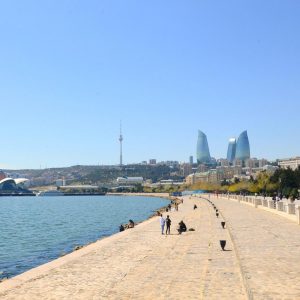
Baku Boulevard For well over a century, the Baku Boulevard has been a beloved recreation area for Baku residents. Over the years it’s gradually been extended and beautified and nowadays, in addition to ever-changing views of the city and Baku Bay, it boasts an abundance of trees and green spaces, making it an ideal escape from the urban hustle and bustle. What’s more, it’s home to a wealth of attractions: Don’t miss browsing the Azerbaijan Carpet Museum, housed in an eye-catching carpet-shaped building and taking you on a memorable journey through Azerbaijan’s UNESCO-listed carpet art. A stone’s throw away is the spectacular Deniz Mall, packed with shops selling the best brands, plus cafes and restaurants galore and three different kids’ entertainment centres. The Bayil end of the Boulevard, beyond Flag Square, hosts the Surakhani Ship Museum – the world’s first oil tanker museum, as well as the Yarat Contemporary Art Centre and the Museum of Azerbaijani Painting of the XX-XXI Centuries. And that’s not all! You can also: take a ride on the Baku Eye, float along the canals of Little Venice, or take a short romantic cruise across the Baku Bay. There are contemporary restaurants and traditional tea houses to relax and refuel in, and you can also explore the Boulevard by bike or electric scooter, both of which are available for rent. |
The Alley Of Martyrs The Alley of Martyrs is an administrative territory in Sabail district of Baku, an alley where our fellow citizens who have died heroically for freedom of the Homeland are buried. Here have been buried Azerbaijani and Turkish soldiers who have lost their lives in the battles for the liberation of Baku from Bolshevik-Dashnak occupation in 1918, as well as those Azerbaijanis who have died heroically during the January events of 1990, and in the Garabagh War.Once called Chambarakand, this area is a burial place for the victims of the genocide committed by Armenians in 1918 in Baku. After the establishment of a Soviet power in Azerbaijan, this graveyard was closed down and the “Upland Park” was laid out in its place. After those perished during the Bloody January events of 1990 were buried here, the area was called the Alley of Martyrs. The proposal to establish the Eternal Flame Memorial was put forward in 1994. The Parliament of Azerbaijan, on the initiative of President Aliyev, subsequently agreed to erect a national monument in memory of Azerbaijani martyrs.Aliyev personally oversaw the project. During the exhibition on the fifth anniversary of Black January, three proposals, including one by sculptor Omar Eldarov, were submitted to the President; he requested several more proposals. The proposal developed by the architect Elbay Gasimzade won the competition. On August 5, 1998, President Aliyev issued an order to erect an Eternal Flame monument in the Alley of Martyrs with funding of 2 billion AZN. |
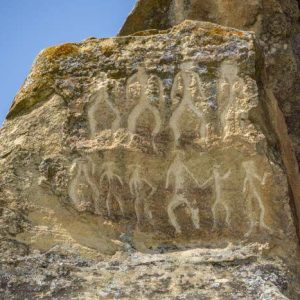
Gobustan From prehistoric rock art to musical stones, the Azerbaijani people’s prehistoric past comes dramatically to life in the Gobustan State Reserve, home to an astonishing collection of over 6,000 ancient petroglyphs. Depicting scenes of people, warriors, animals, boats, dances, hunting, camel caravans and more, they chart ways of life dating back between 5,000 and 20,000 years. Established in 1966 and covering 537 ha, the Gobustan State Reserve is located amid the Boyukdash, Kichikdash and Jingirdagh mountains, about 60 kilometres south of Baku. Besides all the breathtaking rock art, visitors can also explore the remains of caves, settlements and burial grounds used by humans between the Upper Paleolithic and the Middle Ages. Two more of the reserve’s highlights include an inscription left on a rock by a passing Roman soldier in the 1st century AD, the easternmost Roman inscription ever found, and a 2m-long musical stone called a ‘gaval dash,’ which makes a unique tambourine-like sound when struck with a smaller stone. What’s more, just a short drive away you can discover the mystery of Azerbaijan’s many mud volcanoes, one of the world’s most intriguing natural wonders.
|
||||

Fire Temple Let’s begin our exciting journey with a visit to the majestic mosque, restored to its historical splendor and filled with a spiritual atmosphere. Next, we will head to the ancient petroglyphs and unforgettable mud volcanoes, creating otherworldly landscapes. We will visit a mysterious temple, where we will learn about ancient fire-worshiping rituals, and then head to a mountain to see the eternal flame that has been burning for several millennia. We will conclude our excursion at a medieval fortress, where history and architecture create the atmosphere of an era of ancient wars and defense. This route will give you unforgettable impressions and reveal the beauty and mysteries of Baku |
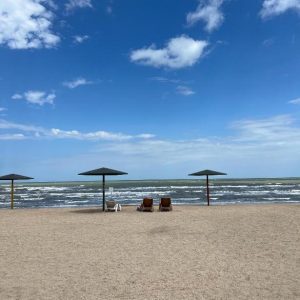
Beach The shores of the Caspian Sea have plenty of excellent beach clubs to enjoy, from the Absheron Peninsula resorts easily reached from Baku to the water sports centre at Shuraabad. There, you will find the perfect conditions for learning to kitesurf on the scenic lagoon and once you’ve mastered the basics you can take your board out into the open Caspian. Both professionals and amateurs can take windsurfing sessions at some Baku beaches. However, if it’s tranquillity and romance you are seeking, make your way to less crowded beaches such as Bilgah, Mardakan, Pirshagi, Nardaran and Zagulba |
Shirvanshah A place where every street, every stone is steeped in history. Here, the spirit of centuries past wafts through majestic walls and narrow alleyways, revealing the richness of our city’s cultural and architectural heritage. Immersed in the sounds of local music, we delve into a world of myths and legends that animate every corner of this remarkable place. As a bonus, during the tour, your guide will take you to the ShekerBura sweets shop, where you can taste the most delicious Azerbaijani sweets! By joining this tour, you’ll have the opportunity to visit Baku’s major attractions, such as: – Maiden Tower – Double Gates (also known as Shemakha Gates) – Palace of the Shirvanshahs – Mosques – The filming location of the legendary Soviet film “Diamond Arm” – where you can recreate the “Chert Poberi” scene! – Monument to Azerbaijani poet Aliaga Vahid – Museum of Miniature Books – Caravanserais – Bathhouses And much more! |
||||
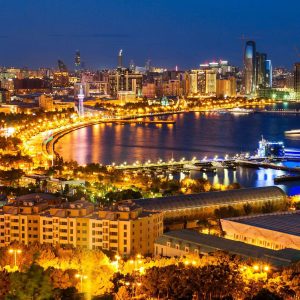
Highland Park Highland Park is one of the most famous and interesting sights of Baku. The green zone is located above Baku Bay. The park in its original form, which has been preserved today, with spacious stairs, shady alleys and cosy terraces, was created by the famous architect Lev Ilyin. During the construction of the Park, Baku limestone was used as the main material. Initially, the territory within the boundaries of which the Nagorny park complex was built called the English Park. At the beginning of the 20th century, there was a burial place of English soldiers who were in Baku after the fall of the Russian emperor in 1918. To date, the only thing that reminds of this is a monument to the departed English soldiers. The construction of the Dagustu Park began in 1935. At this time, a monument to Sergey Kirov, who was the first secretary of the Central Committee of the Communist Party in Azerbaijan, was erected there. Afterwards the construction of the park complex, this place was named Kirov park for several decades. After the completion of the construction of the park, a theatre, attractions, restaurants, and new monuments are being erected within its territory. |
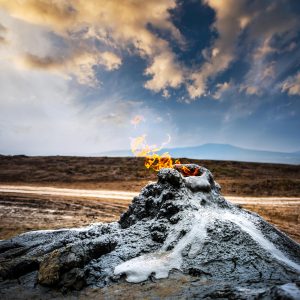
The area around Baku is home to numerous mud volcanoes, considered one of the world’s most unique natural phenomenon. Known for their bubbling mud, they sometimes seem ready to erupt. Approximately 400 of them have been recorded in Azerbaijan. Although smaller than regular volcanoes, they are more frequently active. The diameter of mud volcanoes is typically around 10 metres, and their height can reach up to 700 metres (the world’s largest mud volcanoes – Boyuk Kanizadag and Toraghay – are located in Azerbaijan). Mud volcanoes are formed from tectonic movements that cause underground gases to reach the surface. During this process, some of the escaping gases ignite and burn perpetually. An encounter with Azerbaijan’s mud volcanoes gives visitors a rare chance to behold one of our planet’s most outstanding displays and deepens their understanding of the Earth’s geological marvels. Azerbaijan boasts the world’s largest concentration of mud volcanoes, with over 400 scattered throughout the country, treating visitors to a special opportunity to see the geological rarities and scenic spectacles of the region. These unusual sites are active and constantly changing, with eruptions occurring regularly. Azerbaijan is also renowned for its incredible submarine mud volcanoes. The Caspian Sea is home to over 140 submarine sites, while within the Baku Archipelago, eight islands stand as a testament to their rare origins, forming a truly unique landscape filled with allure and mystery. |
Gala Fortress Azerbaijan is renowned for its unique traditions in various crafts, such as carpet weaving, pottery, the creation of traditional musical instruments, and culinary arts. Gala, with its rich historical heritage and unique atmosphere, is the perfect place to host workshops where participants can explore local crafts and traditions. Workshops in Gala offer a one-of-a-kind opportunity for both locals and tourists to delve deeper into the culture and traditions of the region. Inspired by painting, music, crafts, or cuisine, participants not only acquire new skills but also experience the true spirit of Azerbaijan.At the end of the 17th century, the Jar-Balakan community was formed in the north-western part of Azerbaijan and existed on the stage of history for about 135 years. The Jar-Balakan community is called “Jar-Tala” in the “Jar Chronicle”, which is an invaluable source in the study of the history of the XVIII century. Zagatala used to be called the present-day Jar village. Zagatala administrative district is located on the southern slopes of the Greater Caucasus Mountains, in the Alazan-Ayrichay valley. The establishment of the Safavid state created favorable conditions for the development of the economy, cities and trade in Azerbaijan. During the period of the Azerbaijani khanates, the construction of defense facilities was of great importance, as it was always under the influence of internal strife, attacks and wars. |
||||
|
Ramana Castle It is located on a high hill in the Ramana region, near oi/-wells. At its eastern side, there is a mosque which was built in the 17th century. The gate of the rectangle-shaped exterior rampart is close to the western comer of the northem side. The castle has semi-circular towers at the comers. There is a gate in the rectangular-shaped tower. The inner main tower is rectangular and has semi-circular towers at tfıe corners. The footpaths are supported by stone cantilevers of four and five levels. Their indents are shaped tike a lancet arch. The castle is welf-preserved. The exact construction dae of the castle remains unknown, although some studies argue for a date sometime between the 12th-13th century. |
TV Tower Equipped with the state-of-the-art radio and television equipment, the Complex, which plays an important role in the organization of radio and television broadcasting, space and terrestrial radio communication in our country, was put into operation on August 13, 1996 with the participation of National Leader Heydar Aliyev. It should be noted that the first TV tower, commissioned in 1956, did not meet the new technological requirements, which created difficulties in organizing high-quality radio and television broadcasting on a modern basis. For this reason, the Baku TV Tower Complex was designed and construction began in 1981. According to the project, the construction work was to be completed in 1985. However, due to the financial crisis in the former USSR, the failure to take into account the climatic conditions during construction, the collapse of the USSR and other various reasons, the construction work was left incomplete. After our country gained independence, on the basis of the relevant order of the National Leader Heydar Aliyev, the unfinished construction was completed and the Baku TV Tower Complex was put into operation. The TV Tower, built at the highest point of the capital, allows stable reception of radio waves in any part of the city and within a radius of 70-80 km around Baku, depending on the terrain. |
Crystal Hall Baku Crystal Hall was built in order to host the Eurovision Song Contest 2012.On 2 August 2011, the main agreement was signed with Alpine Bau Deutschland AG to construct the venue and preparations for construction had been started in the area.Although the full cost of the contract was not named, the government is known to have allocated 6 million AZN for the construction of the venue.On 5 September 2011, it was announced that the venue will be able to hold 25,000 spectators.The arena also contains VIP lounges.The construction of the arena was expected to be completed by 31 March 2012.However, there was a delay of three weeks because of weather conditions, and the building was announced to have been completed on 16 April 2012.Baku Crystal Hall was opened on 7 May 2012 by the President of Azerbaijan Ilham Aliyev and First Lady Mehriban Aliyeva. The building has a crystalline shape and illuminated façade with numerous LED lights. The LED lights were upgraded to allow different dynamic lighting scenarios that can highlight the membrane façade and create moods appropriate for different events. |
||||
|
Bibi-Heybat Mosque The Bibi-Heybat Mosque (Azerbaijani: Bibiheybət məscidi) is a historical mosque in Baku, Azerbaijan. The existing structure, built in the 1990s, is a recreation of the mosque with the same name built in the 13th century by Shirvanshah Farrukhzad II Ibn Ahsitan II, which was completely destroyed by the Bolsheviks in 1936. The mosque was built over the tomb of the daughter of the seventh Shiite Imam – Musa al-Kadhim, who fled to Baku from persecution of Abbasid caliphs. On the tomb there is carved on a stone inscription indicating that Ukeyma Khanum belongs to the sacred family: “Here was buried Ukeyma Khanum, a descendant of the Prophet Muhammad, the granddaughter of the sixth Imam Ja’far al-Sadiq, the daughter of the Seventh Imam Musa al-Kadhim, sister of the eighth Imam Ali al-Ridha“.[1]View of the old mosque before restoration in 1911 Based on the writings on the south wall of a mosque, historians attribute the construction by the end of the 13th century. Arabic inscription on the mosque wall reads: “The work Mahmud ibn Sa’d“, which is the same architect who built the Nardaran Fortress near Baku. Haji Sheikh Sharif was among many Muslims who is buried near the mosque. He arrived in Baku to spread Sufism, and spent the rest of his life in this mosque.
|
Turkish Mosque Baku, the vibrant capital city of Azerbaijan, is known for its rich history and stunning architecture. One of the must-visit attractions in Baku is the Mosque of the Martyrs, also known as the Turkish Mosque. Situated near the Martyrs’ Lane, this mosque holds great historical significance and offers a glimpse into the country’s past. The Mosque of the Martyrs was built in the early 1990s with the assistance of the Turkish government. It stands as a memorial dedicated to the Ottoman soldiers who lost their lives during World War I in Azerbaijan. These soldiers fought alongside Azerbaijani forces against the Bolsheviks, Armenian Dashnaks, and Baku Soviets in the Battle of Baku in 1918. Designed by Turkish architects Hüseyin Bütüner and Hilmi Güner, the mosque features a unique architectural style. Its two-story pyramidal frustum structure with square bases and truncated corners gives it an octagonal frustum appearance. The exterior is covered in red granite, adorned with star and crescent figures made of pure white marble, reminiscent of the Turkish national flag. Visiting the Mosque of the Martyrs offers a chance to explore both its historical significance and architectural beauty. Take a stroll through the Martyrs’ Lane, where an alley with name plates of the fallen soldiers leads to the mosque. The surrounding walls display the names of the martyrs, along with their military rank, hometown, and place of death. |
Deniz Mall Located on land reclaimed from the Caspian Sea, Deniz Mall is a 120,000m² entertainment, leisure and dining destination over five floors. It is Azerbaijan’s premier entertainment venue.Originally designed by Chapman Taylor in 2007 as a congress centre, the building was repurposed to include five levels of entertainment, leisure, F&B and retail. Our design for the interior is harmonised with the exterior design to provide a single homogenous concept for the entertainment centre.A ‘flame’ tower is the centrepiece of eight star-shaped wings inspired by Azerbaijan’s national emblem. The development’s complex geometry was modelled by Chapman Taylor in BIM software, as well as deliverables including drawings, schedules and visualisations. Chapman Taylor co-ordinated the design process across multiple studios live in these models. Located on land reclaimed from the Caspian Sea, Deniz Mall is a 120,000m² entertainment, retail, leisure and dining destination over five floors, housing the largest shopping centre in the Caucasus region. A ‘flame’ tower is the centrepiece of eight star-shaped wings inspired by Azerbaijan’s national emblem. |